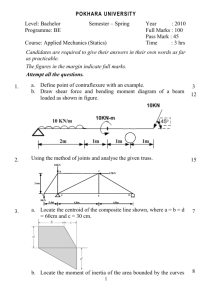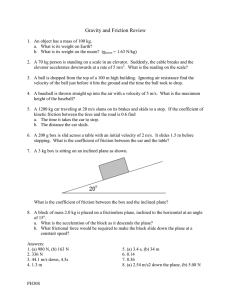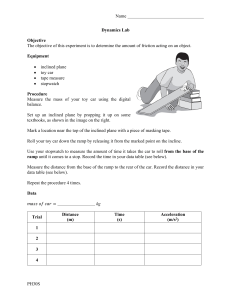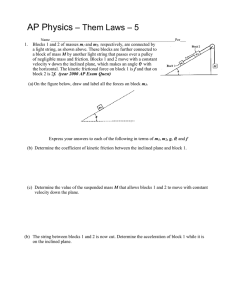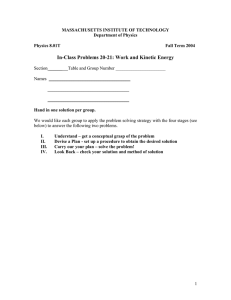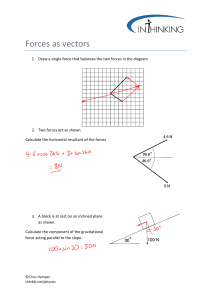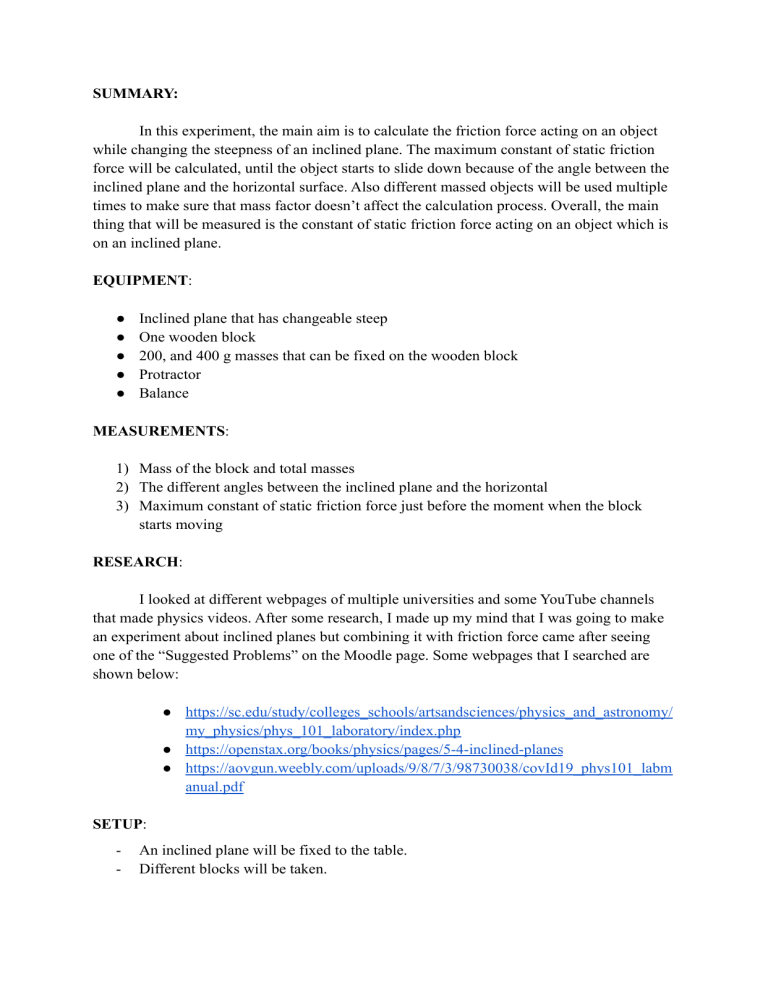
SUMMARY: In this experiment, the main aim is to calculate the friction force acting on an object while changing the steepness of an inclined plane. The maximum constant of static friction force will be calculated, until the object starts to slide down because of the angle between the inclined plane and the horizontal surface. Also different massed objects will be used multiple times to make sure that mass factor doesn’t affect the calculation process. Overall, the main thing that will be measured is the constant of static friction force acting on an object which is on an inclined plane. EQUIPMENT: ● ● ● ● ● Inclined plane that has changeable steep One wooden block 200, and 400 g masses that can be fixed on the wooden block Protractor Balance MEASUREMENTS: 1) Mass of the block and total masses 2) The different angles between the inclined plane and the horizontal 3) Maximum constant of static friction force just before the moment when the block starts moving RESEARCH: I looked at different webpages of multiple universities and some YouTube channels that made physics videos. After some research, I made up my mind that I was going to make an experiment about inclined planes but combining it with friction force came after seeing one of the “Suggested Problems” on the Moodle page. Some webpages that I searched are shown below: ● https://sc.edu/study/colleges_schools/artsandsciences/physics_and_astronomy/ my_physics/phys_101_laboratory/index.php ● https://openstax.org/books/physics/pages/5-4-inclined-planes ● https://aovgun.weebly.com/uploads/9/8/7/3/98730038/covId19_phys101_labm anual.pdf SETUP: - An inclined plane will be fixed to the table. Different blocks will be taken. PROCEDURE: 1) 2) 3) 4) 5) 6) Masses of the blocks will be found by using a balance. They will be noted down. Inclined plane will be set at an angle like 15 degrees. Inclined plane’s angle will be calculated with the protractor. tanθ = y/x of the inclined plane. One of the wooden blocks will be taken and put on the inclined place. Different angles will be obtained and the angle that the block starts moving will be noted down. 7) Static friction force will be found from that angle. The two equations below will be used: Fstatic = m.g.sinθ Fnormal = m.g.cosθ 8) The same experiment will be constructed by adding different masses on the wooden blocks to see that the mass of the blocks don’t affect the constant of static friction force on an inclined plane. TABLES TO RECORD THE DATA: Table1: mass of the blocks vs static friction force constant table Block Identity Block Mass (g) Max Constant of Static Friction Force (μs) Angle that Causes the Max Friction Force (μs) block block + 200g block + 400g Table2: angle of the inclined plane vs static friction force constant table Block Identity Block Mass(g) Angle(θ) tanθ block π/12 0.268 block π/6 0.577 block π/4 1.000 block π/3 1.732 Static Friction Force (μs) block max θ for μs block + 200g π/12 0.268 block + 200g π/6 0.577 block + 200g π/4 1.000 block + 200g π/3 1.732 block + 200g max θ for μs block + 400g π/12 0.268 block + 400g π/6 0.577 block + 400g π/4 1.000 block + 400g π/3 1.732 block + 400g max θ for μs PROCEDURE TO ANALYZE DATA: 1) Mass of Blocks vs. Static Friction Constant graph will be drawn in order to conclude that mass of the blocks do not affect the maximum static friction force constant. 2) Angle of the Inclined Plane vs. Static Friction Constant graphs for different masses of blocks in order to find the maximum angle that the block stays immobile, and the maximum constant for static friction. THEORY FOR THE RESULTS: - Maximum static friction force constant on an inclined plane is independent of the mass of the objects and the angle of the inclined plane directly affects the friction constant. These theory will be derived by using the laws and formulas mentioned below: - Newton’s Laws: to show the free body diagrams of the wooden blocks - Friction formulas: Ffrictionstatic = m.g.μs
